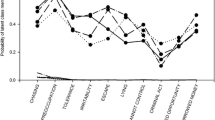Abstract
The current study sought to identify which diagnostic criteria for gambling disorder have the greatest ability to differentiate between social and problem gamblers. This study was conducted on a sample of male and female college student athletes across the U.S. (n = 8674). Classification and regression tree analysis represents an appropriate technique when addressing the question of an item’s diagnostic value, as it sequentially selects variables to isolate sets of observations with similar outcomes. The current results suggest that the item related to preoccupation (“Have there been periods in the past year where you spent a lot of time thinking about gambling?”) was the DSM-5 item best able to differentiate between male and female social and problem gamblers in this sample. When considering only the nine criteria retained in the DSM-5, three criteria were identified as key for distinguishing between social and disordered gamblers among men, and one criterion was identified for distinguishing between groups of women. In addition, these results do not support the notion that the illegal acts criterion has a particularly low base rate and found that it can be an important indicator of disordered gambling in a college-aged sample.


Similar content being viewed by others
References
American Psychiatric Association. (1980). Diagnostic and statistical manual of mental disorders (3rd ed.). Washington, DC: American Psychiatric Association.
American Psychiatric Association. (1994). Diagnostic and statistical manual of mental disorders (4th ed.). Washington, DC: American Psychiatric Association.
American Psychiatric Association. (2000). Diagnostic and Statistical Manual of Mental Disorders (4th ed.—text revision). Washington, DC: American Psychiatric Association.
American Psychiatric Association. (2013). Diagnostic and statistical manual of mental disorders (5th ed.). Washington, DC: American Psychiatric Association.
Breiman, L., Friedman, J. H., Olshen, R. A., & Stone, C. J. (1984). Classification and regression trees. Belmont, CA: Wadsworth International Group.
Gotestam, K. G., Johansson, A., Wenzel, H. G., & Simonsen, I.-E. (2004). Validation of the Lie/Bet screen for pathological gambling on two normal population data sets. Psychological Reports, 95(3), 1009–1013.
Gupta, R., & Derevensky, J. (1996). The gambling activities questionnaire. Montreal: McGill University.
IBM. (2012). IBM SPSS statistics for windows, version 21.0.. Armonk, NY: IBM Corporation.
Mitzer, G. B., Whelan, J. P., & Meyers, A. W. (2010). Comments from the trenches: Proposed changes to the DSM-V classification of pathological gambling. Journal of Gambling Studies, 27, 517–521.
Monahan, J., Steadman, H. J., Silver, E., Appelbaum, P. S., Robbins, P. C., Mulvey, E. P., et al. (2001). Rethinking risk assessment: The MacArthur study of mental disorder and violence. New York: Oxford University Press.
Paskus, T. S. (2013). Using exploratory data mining to identify academic risk among college student-athletes in the United States. In J. J. McArdle & G. Ritschard (Eds.), Contemporary issues in exploratory data mining in the behavioral sciences (pp. 345–370). New York: Routledge.
Petry, N. M. (2010). Pathological gambling and the DSM-V. International Gambling Studies, 10(2), 113–115.
Petry, N. M., Blanco, C., Stinchfield, R., & Volberg, R. (2012). An empirical evaluation of proposed changes for gambling diagnosis in DSM-5. Addiction, 108(3), 575–581.
Potenza, M. N. (2013). Neurobiology of gambling behaviours. Current Opinion in Neurobiology, 23(4), 660–667.
Stinchfield, R., Govoni, R., & Frisch, G. R. (2005). DSM-IV diagnostic criteria for pathological gambling: Reliability, validity and classification accuracy. The American Journal on Addictions, 14, 73–82.
Strobl, C., Malley, J., & Tutz, G. (2009). An introduction to recursive partitioning: Rationale, application, and characteristics of classification and regression trees, bagging, and random forests. Psychological Methods, 14(4), 323–348.
Temcheff, C. E., Derevensky, J. L., & Paskus, T. (2011). Pathological and disordered gambling: A comparison of DSM-IV and DSM-V criteria. International Gambling Studies, 11(2), 213–220.
Author information
Authors and Affiliations
Corresponding author
Rights and permissions
About this article
Cite this article
Temcheff, C.E., Paskus, T.S., Potenza, M.N. et al. Which Diagnostic Criteria are Most Useful in Discriminating Between Social Gamblers and Individuals with Gambling Problems? An Examination of DSM-IV and DSM-5 Criteria. J Gambl Stud 32, 957–968 (2016). https://doi.org/10.1007/s10899-015-9591-5
Published:
Issue Date:
DOI: https://doi.org/10.1007/s10899-015-9591-5



